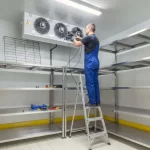Working Principles of Coolroom Panels
- 09 October 2020
Meat processors, fresh produce distribution centres, and other cold storage facilities typically utilise coolrooms, freezers, and other refrigeration systems to effectively store perishable and consumable products. By regulating the temperatures at the recommended levels, these rooms and systems help these facilities preserve the quality of food items, operate optimally, and save a large amount of money.
But aside from coolrooms and refrigeration units, there is one thing that commercial facility owners can do to further preserve and maintain the condition and quality of their products. They can opt to install coolroom panels all over a refrigerated or coolroom since they can control the storage temperatures of any given room as well as meet specific regulations. Coolroom panels are also known for other features that can be beneficial for commercial facilities.
Common Insulating Materials
The basic working principles of coolroom panels heavily rely on the type of material that they are made of. Some of the most common insulating materials for coolroom panels are expanded polystyrene foam, extruded polystyrene foam, polyisocyanurate foam, and polyurethane foam. Most coolroom panels are made from polyurethane foam due to its lightweight and ease of application. Polyurethane foam is also known for its low thermal conductivity and resistance against sudden weather or temperature changes.
If there is one value that you should know about these insulating materials, that would be their corresponding R-value. This value represents the rating of a material’s resistance to heat flow. Materials that have high R-value are known to be more effective in regulating heat flow. However, materials with high initial R-values do not mean that they can resist heat flow throughout their service life since they might dissipate over time. Materials with low initial R-values usually stay the same in the long run.
Overall Structural Layout
Coolroom panels have been effective in regulating temperatures due to their efficient structural layout. These panels are typically comprised of an insulating layer that is sandwiched between two strong structural materials. The core of these panels may be made from the materials that are previously mentioned, while the sandwiching structural materials can be made from sheet metal, plywood, cement, magnesium oxide board, or oriented strand board.
The multiple layers of insulating and structural materials of coolroom panels enable them to resist extreme heat transfer. These materials also help the panels become strong and stable so that they can withstand any damaging elements from their surroundings. Their functionality and durability allow the panels to be installed as a wall, roof, and flooring of a refrigerated or coolroom.
Insulation and Coolroom Panels
The flow of heat can be described in several ways. For one, the way heat moves through materials is best described by conduction. Convection, on the other hand, is the movement of heat through liquids and gases. Ultimately, radiation is the transmission of heat in the form of waves, which then warms every solid object along its path or direction.
With coolroom panels, their insulating materials can help commercial facilities decrease the speed of conductive and convective heat flow. These same materials also protect cold spaces from intense heat and allow these areas to maintain their set interior temperatures. As a result, coolroom panels can make the place more comfortable, preserve the freshness of food products, and save equipment and other products from getting heat or moisture damage.
Mark Connelly
C&M Coolroom Services
E-mail : markconnelly@cmcoolrooms.com.au
Mobile: 0412 536 315


